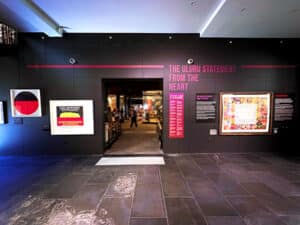Media Release, Histories of First Nations advocacy and reform showcased in new temporary display, South Australian Museum, 25 September 2023

From 21 September, the South Australian Museum will host a free educational display featuring the Uluru Statement from the Heart alongside a selection of historic objects from the Museum’s collection, in a display that chronicles the history of First Nations advocacy and reform in Australia.
The culmination of thirteen Regional Dialogues held across Australian in 2016-17, the Uluru Statement from the Heart was drafted at the First Nations Constitutional Convention at Uluru in May 2017. Marking the 50th anniversary of the 1967 Referendum, 250 First Nations delegates formed a consensus that applied the insights from the Regional Dialogue into a call for structural reform and constitutional change.
This Statement, signed by Convention delegates, is bordered by paintings of important Tjukurpa (Dreaming stories) of Anangu traditional owners of Uluru, created by artists from Maruku Art Centre in Mutitjulu led by Rene Kulitja, alongside Charmaine Kulitja, Christine Brumby and Happy Reid.
As the Australian people prepare to vote on an Aboriginal and Torres Strait Islander Voice, one element of reform canvassed in the Uluru Statement from the Heart, the South Australian Museum will for a limited time display the Statement from the Heart as an important piece of history and an opportunity for broader public education.
Alongside a replica of the original Statement canvas, the Museum will showcase a selection of significant pieces from its collection, including part of the first Aboriginal flag, designed by Luritja and Wombai artist and former Museum employee Harold Thomas.
Created in 1971 while Thomas worked at the Museum and first flown at a protest in Tarntanyangga / Victoria Square in July that year, the design quickly became an iconic symbol for First Nations peoples and was granted official flag status in 1995. The original flag is thought to be lost, but a circular offcut was retained by Thomas’ Museum colleague Sandy Hanson who sewed the final product, and it offers a poignant insight into how history is made.
The display will also include an original poster from the 1967 Referendum – which saw more than 90 per cent of the electorate back a proposal to include Aboriginal peoples in the census and empower the Federal government to make special laws about them for First Nations communities – and a poster commemorating the 1985 ‘Handback’ of Uluru Kata Juta National Park to the Anangu traditional owners.
South Australian Museum Director Dr David Gaimster said the display offered a safe space for visitors to view the Uluru Statement from the Heart’s message.
“This remarkable opportunity has been enabled by the Uluru Dialogue, the custodians of the canvas who were tasked by the Uluru Convention to take forward and explain the Uluru Statement’s requested reforms to the Australian people,” said Dr Gaimster.
“For over 165 years the South Australian Museum on Kaurna Yarta has been entwined with First Nations communities, often in ways that mirror the broader story of the colony and the nation,” said Dr Gaimster.
“From a colonial institution driven by Western ideas of knowledge, the Museum is evolving as a site of public education, understanding, community, truth telling and reconciliation.
“By bringing this replica of the Uluru Statement from the Heart to the Museum alongside these important pieces from our collection, we hope visitors will be able to reflect on its place in history, and their own.”
ENDS
For more information or to organise an interview please contact:
- Walter Marsh, Communications Lead, South Australian Museum
0466 389 019 | [email protected]
OR - Amy Haring, Manager, Marketing and Communications
0434 880 950 [email protected]
Images available via Dropbox
About the South Australian Museum
The Museum cares for a wealth of treasures with national and international significance – it is admired for its world class collections, which have been amassed over more than 150 years and encompass everything from fossils of the first known life on Earth to pieces of Martian meteorites. The Museum’s collections are still growing and used each day in scientific and cultural research.
The Museum is one of Australia’s most successful research museums, with 147 scholarly publications and presentations in 2021/2022 and is a strong partner, with strategic relationships across the resources sector as well as with state and federal governments.
